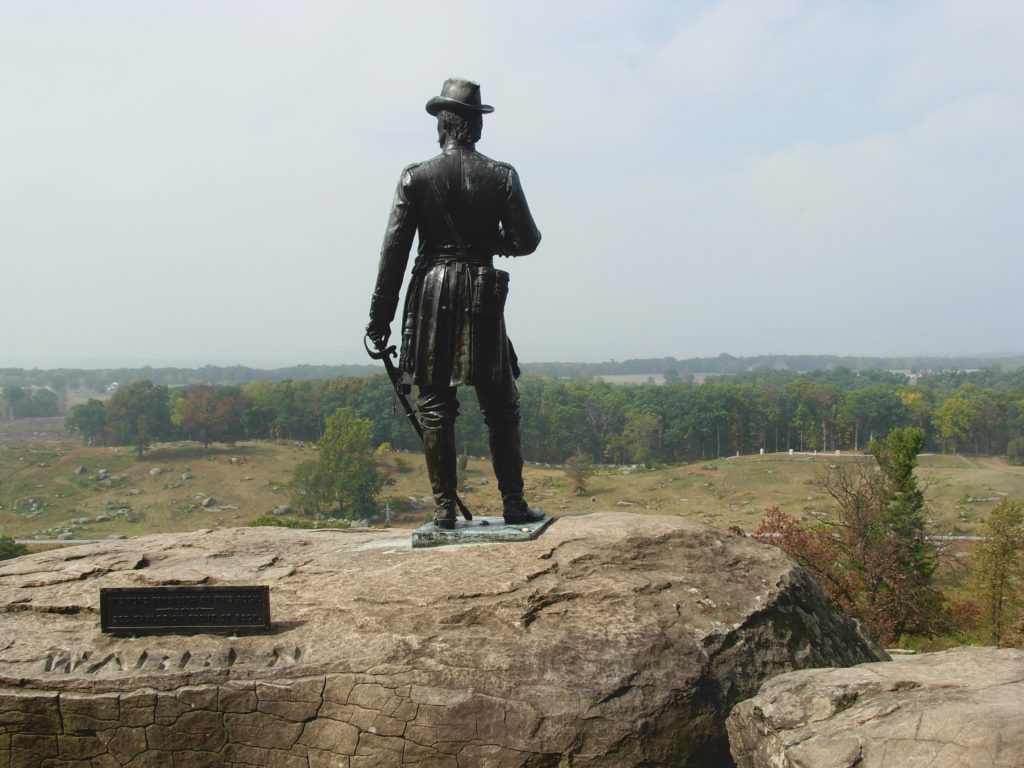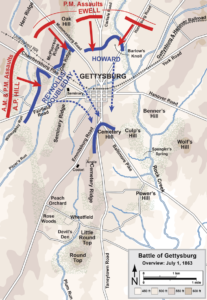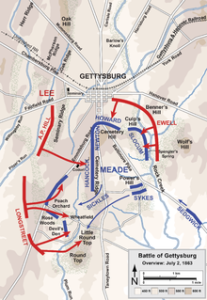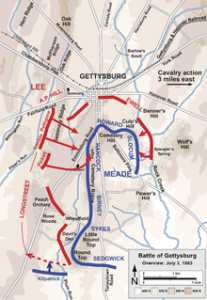
Today’s society is inwardly directed and struggles to grasp the forces of history that often re-orient destiny. When the republic was newer, however, and more attuned to the circumstances and elements of its birth, most citizens had an acute recognition of the role of action and consequence. The concept of historical crossroads, a point of time at which the direction of the arc of history is called, was acknowledged by all to be present at Gettysburg, Pennsylvania in early July, 1863. The bitter battle over who owned the correct interpretation of the events of the American Revolution had slogged its way through two years of horrific struggle, but the indeterminate outcome thus far had only sharpened the the intensity of the philosophical commitment to determine the owners of the arc. As Lincoln so presciently remarked in his ‘house divided’ speech in 1858:
I do not expect the Union to be dissolved – I do not expect the house to fall – but I do expect it will cease to be divided.
It will become all one thing or all the other.
The first six months of 1863 had wetted the appetite of the confederate military leader of the Army of Northern Virginia, Robert E. Lee, to bring a finality to Lincoln’s epic conceptualization. Two crushing victories over attacking Union forces at Fredericksburg in December, 1862, and Chancellorsville in May, 1863, had led Lee to dare to visualize a path to ultimate victory, predicated upon a penultimate battle on the Union’s own territory. Lee saw the Union forces as worn down, divided, and the Union states weary of the devastating cost of battle and indifferent to Lincoln’s vision. He was confident, and he was wrong, but this particular historical arc required that the question be called and destiny be played out.
The crossroads of history would therefore have a virtual and actual set-piece in the little town of Gettysburg, Pennsylvania. A unique confluence of actual crossroads and logistical support needs led the massive Union and Confederate Armies to congregate on Gettysburg on the 1st of July, 1863. Five roads intersected the little town from the north, three from the south through some of the most fertile and prosperous farmland in the world.

In a somewhat fortuitous twist of fate, the Confederate army would enter from the north, the Union army from the south. The initial battles took place north and west of town as Union forces led by General John Reynolds initially contacted and repulsed Confederate brigades at the tip of the spear, but as the mass of General Ewell’s confederate Second Corps arrived, the Union forces were pushed to and through Gettysburg into a defensive position on Cemetery Hill, with the crushingly painful mortal loss of Reynolds to a bullet. An over-confident Lee, somewhat blinded by the absence of his ‘eyes’ , the cavalry force led by Jeb Stuart, inadvertently caught on the wrong side of Union General Meade’s Army of the Potomac, did not recognize the bulk of the Union Army had successfully crossed the Potomac River, and looked to roll up his union opponents in a devastating piecemeal fashion. Meade, however, proved infinitely better than his predecessors in mobilizing force and by the morning of July 2nd, had created a ‘fishhook’ defensive line which he was able to reinforce as necessary.
The following two days of battle stand as immortal lore in the discussion of courage, fortitude, devastating loss, and magnificent victory.
The sun rose on July 2nd with Lee striving to develop his ‘role up’ plan with massive attacks to the flanks of the Union army, hoping to crush it upon itself similar to Stonewall Jackson’s attack at Chancellorsville, but Lee had no Stonewall Jackson, as Jackson had been accidentally struck down by one of his own snipers at Chancellorsville at the moment of victory.

Lee instead relied upon a coordinated attack from General Ewell’s forces upon Culp’s hill to the north, and General Longstreet and Hill from the south against Cemetery Ridge. This being an era of slow and incomplete communication, no significant coordination ever developed, and the battered Union forces heroically managed to hold against massive and fierce assaults from Longstreet at the Devil’s Den and Little Round Top. Despite huge losses, the Union lines held and Meade was able to mobilize 20,000 troops to fill the breaches to the defensive line caused by the day’s violence. All day long, Confederate forces had come within yards of a full breach of the Union flank, with vicious hand to hand combat between individuals and their recognition of the crucial nature of their historical role determining the fate of tens of thousands, and ultimately, the fate of a nation. On the evening of July 2nd, Lee convinced himself that the Union Army, softened by years of inept and indecisive generalship, would finally crumble under the pressure of pointed overwhelming force aiming to split the Union Army in half and drive through its reserves. Despite the events of the day, Lee had a prismatic view of the indestructible capability of his troops and their rightful place in Providence, and sought to raise the final call to question of July 3rd.
The crossroads of history weighed heavily across an open field in the early afternoon of an oppressively hot day on the 3rd of July, 1863 in Gettysburg, Pennsylvania. The terrible, heroic beauty of the specific battle known down through time as Pickett’s Charge have been rendered by Ramparts in 2011, and worthy of a separate read.

General Lee’s vision of the tip of an irresistible force driven to and through a tiny door, at the angle of a low stone wall, was undertaken in the epic form associated with the mythical heroes of the Iliad. An initial artillery bombardment, designed to create a porous defensive wall was undertaken by Confederate artillery. The door was to be blown open, and then thousands of troops would then pour through and rout the core of the Union forces and, indirectly the Union state’s morale to continue the war itself. The artillery barrage, though massive, struggled to concentrate, and much of the damage sailed over the frontline, leaving it intact. From the concealing trees of Seminary Ridge came Pickett’s ten thousand, across the open field, focused like a laser on the door to victory, and their place in determining the outcome of this crucial crossroad of history. Once again, in a battle of tens of thousands of surging and seething armies, the tiny angle of a farmer’s stone wall on Cemetery Ridge just past the Emmitsburg Road held a future world of either freedom or servitude in the hands of several hundred men. Each man on the angle assumed himself the final arbiter, one determined to be invincible, one immovable – and history wavered and heaved in the heat.
In the end the attack was repulsed, and Lee’s view of an unconquerable Confederate force protected by Providence lay in taters, along with the Union Army’s previous sense of Lee’s invincibility as a leader of men.
The crossroads at Gettysburg had led ten thousands of men to an intersecting fate, and thousands of men to their deaths. The largest armies that had ever faced across a battle field on the North American continent, had resulted in the largest number of casualties ever suffered on the North American continent, over 50,000 for the combined armies over the course of the campaign.
On the nation’s birthday, July 4th, 1863, the call to question – a house divided against itself cannot stand — combined with the conclusive victory of General Grant at Vicksburg on the very same day, was answered affirmatively and indisputably on the side of individual freedom. The war would go on for two more long years, with much sorrow and loss to come, but the verdict of history would never be in question again for this uniquely American arc.
We face our current July 4th with a population versed on the day being a holiday of fireworks and picnics, but with little connectivity to the unique fundamentals of individual liberty birthed on that specific day in 1776, or dramatically and heroically sacrificed for in 1863. A physical battle is not what is wanting in this country. Rather it is an intellectual one, based on individuals versed on what is at stake with every won freedom, overcoming those who are blithely ignorant of what is irretrievably lost in their self absorbed drive toward passivity and security.
On this 4th of July, enjoy the fireworks and friends, but take some personal time to absorb all that has come before and help to make the amazing country we inhabit today. Grab a copy of a founding document, and take a minute to digest its profound wisdom. There is no room for a house divided. We all inhabit the same house of freedom.
Beautifully written…a prescient call for all of us.